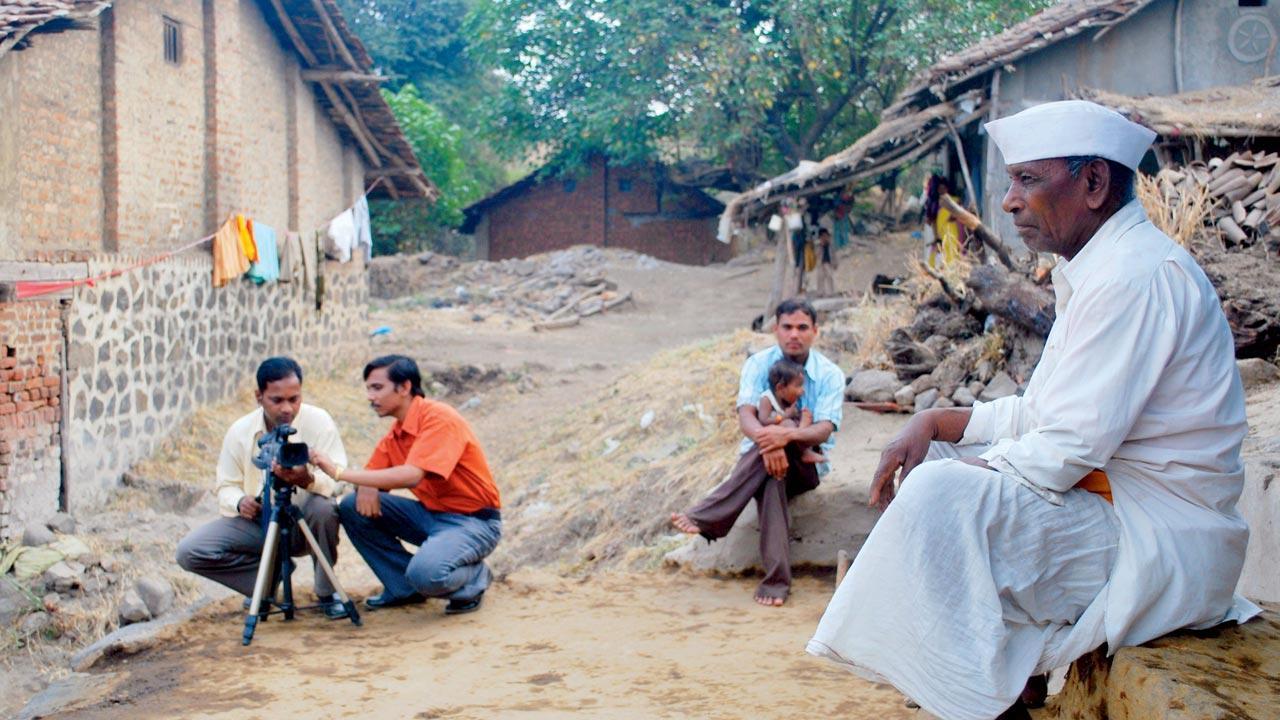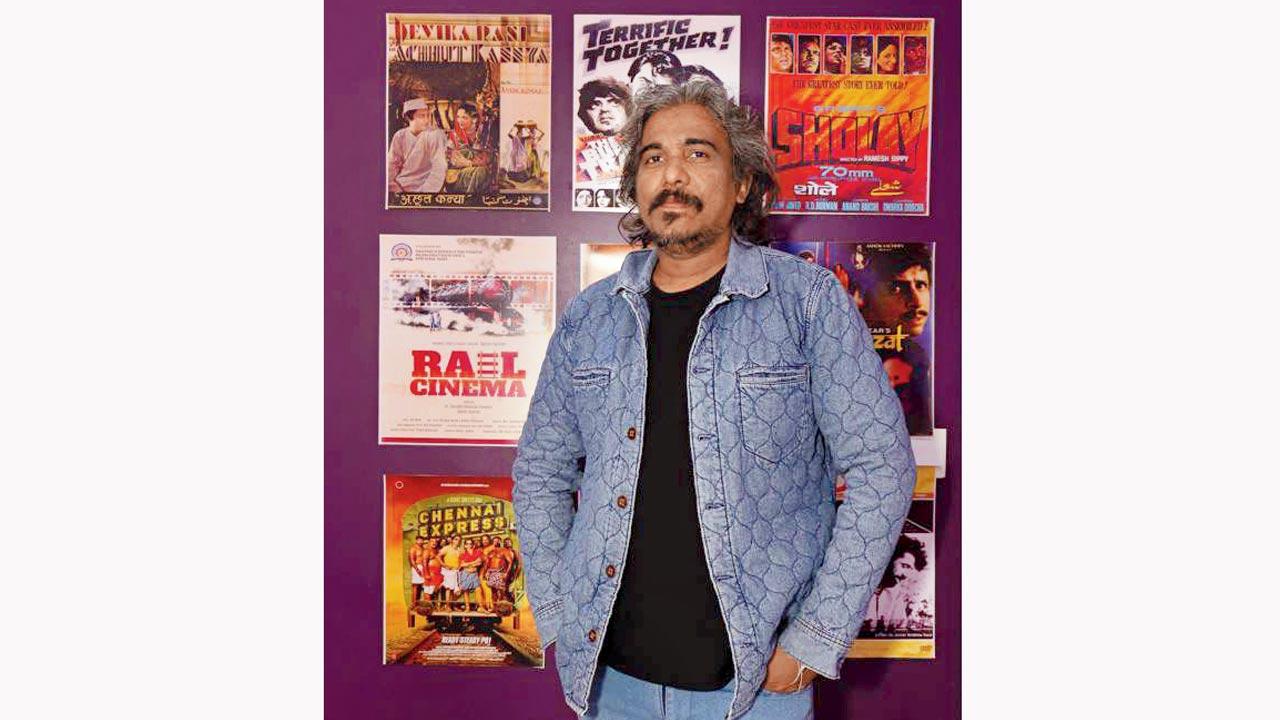A new documentary maps Indian cinema narratives centred around the railways, which contribute robustly to our idea of a nation

Behind the scenes with a retired railway gangman at Padali in Igatpuri taluka
![]() Railroad journeys in India are a fantastic way to explore the country’s geographical diversity. The Indian Railways, now 170 years old, offer the best scenic routes in the world; a journey imparts an instant connect with a vibrant passenger mix. Which Indian doesn’t have a treasured railway memory of either talking to strangers for hours on a night trip or exchanging home-cooked parathas in a shared coupe! Indian trains—the royal carriers, packed passenger cars, goods trains, toy trains, bullet versions—have inspired creators of all hues.
Railroad journeys in India are a fantastic way to explore the country’s geographical diversity. The Indian Railways, now 170 years old, offer the best scenic routes in the world; a journey imparts an instant connect with a vibrant passenger mix. Which Indian doesn’t have a treasured railway memory of either talking to strangers for hours on a night trip or exchanging home-cooked parathas in a shared coupe! Indian trains—the royal carriers, packed passenger cars, goods trains, toy trains, bullet versions—have inspired creators of all hues.
The latest in the category of railway fans is filmmaker-artist Sachin Susheel, 40, whose 40-minute documentary, recently screened in Nasik, dwells on the connect between the Indian Railways and Indian films. Rail Cinema is researched and scripted by Susheel, in collaboration with Nasik-based Maratha Vidya Prasarak Samaj’s KTHM College.
ADVERTISEMENT
Dr Saurabh Khawale and Susheel have co-directed the venture. Voiceover artist Adil Shaikh’s resonating Hindi commentary (with English subtitles) journeys through iconic and little-known Hindi and regional movies which draw their energy from the Indian Railways. Susheel and team see the railways and cinema as twin streams which shape each other and ultimately contribute to nation building.
 The railways provide a defining backdrop to numerous films, says Sachin Susheel
The railways provide a defining backdrop to numerous films, says Sachin Susheel
The centrality of the railways in Bollywood is a subject of many academic studies as well as popular discourse. But Susheel’s relationship with the Indian Railways is personal and finds a unique expression in many back stories. He derives positivity from two popular numbers, Ruk jana nahin tu kahin haar ke and Gadi bula rahi hai. Susheel’s family holidays are essentially railway moments—either a long trip to Kashmir to a toy train ride in Matheran. Interestingly, Susheel’s love for photography and videography also facilitated his personal footage of moving and still trains, which became his repository for Rail Cinema. His first job as cameraman at IIT Bombay brought him in close contact with visual thinkers who further encouraged him to take on shooting for full-fledged documentaries.
Susheel is born in a family where both his grandfathers and every uncle and elder cousin served in the railways, particularly Central Railway. While he was born and raised in Mumbai, the Pagare family transitioned from Chandori (a village six km from Nasik) to Ulhasnagar a little after Independence. Susheel’s late father worked in the accounts office at CSMT until 2010; he was also a senior functionary in the railway trade union. His home was a meeting point for many loco pilots, booking clerks, loco shed helpers, ticket checkers and other moderately-paid rail employees. His paternal grandfather worked as a Keyman (Gangmen category) in the track section in Thane; while the maternal patriarch was an A grade repeater.
Susheel was impacted immensely by the story of his paternal grandfather’s death on the rail tracks in 1960. “I was born much later, but ajoba’s death on duty [in the Parsik Tunnel; a dual-line railway tunnel east of Thane] was a tragic moment for the family. I grew up thinking and dreaming of a film that I will make as a homage to ajoba and similar souls—skilled people—who do hazardous work on railway tracks to keep the passenger rail lines safe.”
Susheel’s dream project first took the form of a short documentary titled Gangman, inspired by a category of staff that’s the backbone of the Indian Railways—a track maintainer who belongs to a specific group, or gang. It premiered at the Central Railway Auditorium, CSMT. Even as he is busy with Rail Cinema, Susheel plans to showcase his research in an upcoming book. “Our cinema literally runs on the wheels of the Indian Railways. Railways have offered [directors] great locales, turning points [in plot], climactic scenes, reunion possibilities, and suspenseful thrill. I think the subject deserves a deeper treatment in all forms of art,” says Susheel, who has dabbled in multiple ventures ranging from the theatrical reading of Marathi poet Manik Sitaram Godghate or Grace’s works to an interview series on the history of Indian animators to writing a rap song inspired by the railways.
For this film, he devoted three years to research, procuring rare photos from the State Central Library in Mumbai and the Film and Television Institute in Pune, after following copyright rules. His efforts took off well when the KTHM College video production and animation unit joined hands and the documentary was made part of curricular learning.
Rail Cinema is Susheel’s recall of all Indian films shot on railway locations, including those that use the train journey as a metaphor for long-term bonding, a rightful space for dialogue, a platform for unending exchanges! He begins at the beginning—in 1913, tracing the first Indian silent film Raja Harishchandra directed-produced by Dadasaheb Phalke, the visionary who was mindful of the impact of technological advances (including railway engines) which transformed Indians forever. Susheel quotes the Marathi commemorative feature, Paresh Mokashi’s Harishchandrachi Factory, in which Phalke fondly mentions the feared advent of the railways in India; Phalke’s rail journeys evoke the mounting odds in his trial-and-error filmmaking process.
Susheel’s documentary goes back and forth in chronology to bring home the cinema moments which hinge on railway settings. Achhut Kanya’s comment on rigid caste hierarchies gains its edge from the heroine’s death at the railway crossing. Similarly, all movies based on the Partition and resultant communal carnage (Chhalia, Train to Pakistan, Gadar) derive their vitality from recreated railway stations/yards/compartments loaded with refugees and migrants. The ‘railgaadi’ moments come in quick succession, varied and nostalgic. From Harindranath Chattopadhyay’s Railgaadi chuk chuk chuk chuk to the trademark Mere sapno ki rani kab ayegi tu, we are treated to a musical sojourn. The viewer seems to board a moving train which stops at strategic railway junctions—we meet the bedecked dulhan of Neel Kamal departing with baabul ki duaein; Inspector Thakur Baldev Singh chasing Gabbar’s men in a goods train; Kitaab’s ticket checker who saves an absconding minor; the Sadma-free heroine regaining her memory.
The Indian identity reflects in many popular symbols—tea, masala, sarees, yoga and the Indian Railways too. At a time when India’s cultural make up, plurality, porousness and unity-in-diversity are being questioned, Susheel’s film shows two extraordinary aspects that bind Indians, the railways and movies.
Sumedha Raikar-Mhatre is a culture columnist in search of the sub-text. You can reach her at sumedha.raikar@mid-day.com
 Subscribe today by clicking the link and stay updated with the latest news!" Click here!
Subscribe today by clicking the link and stay updated with the latest news!" Click here!








